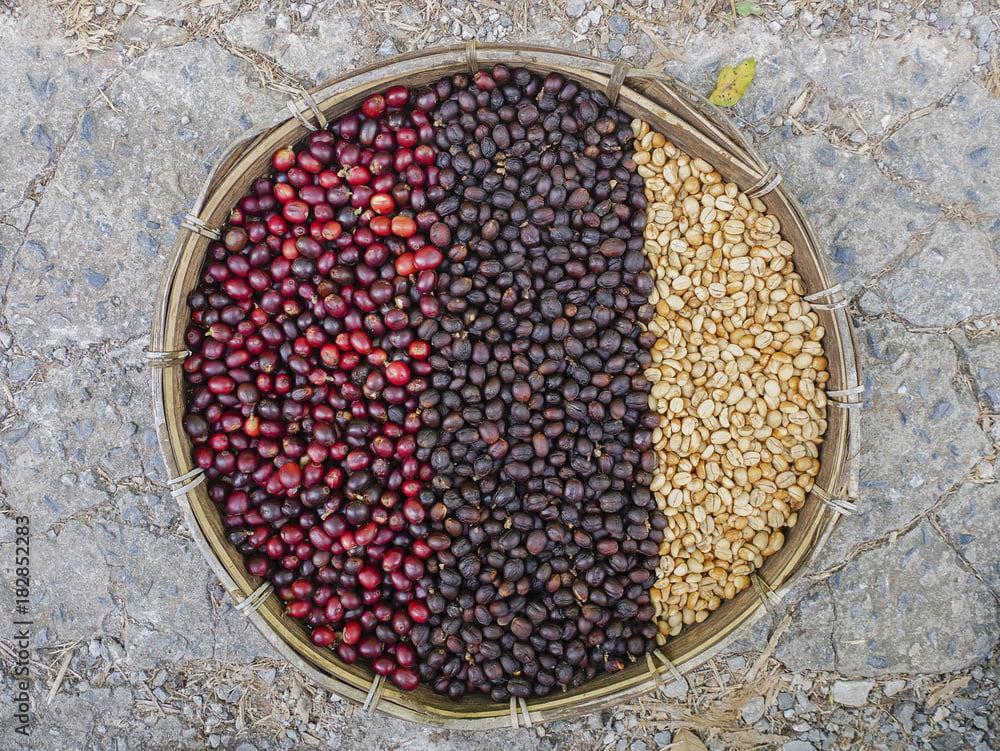Coffee drying is one of the most important steps in the coffee production process, directly affecting its quality and final flavor. After harvesting, the coffee beans are extracted from the cherries and then carefully dried to preserve their aromatic oils and unique flavor. Drying methods vary from traditional sun drying to mechanical drying, each with its own unique impact on the coffee's flavor. In this article, we'll explore the stages and methods of coffee drying, and the key factors that ensure high-quality beans.
What is the coffee drying process?
Coffee drying is a crucial step in coffee production, reducing the moisture content of coffee beans after harvest to ensure quality and protect them from rot or spoilage. This process aims to bring the moisture content of the beans to around 10-12%, making them easier to store and roast later for the best possible flavor.
The drying process is done in three main ways:
- Natural drying (sun drying): Whole coffee cherries are spread out on wide surfaces and dried in the sun, constantly turning them to ensure even drying.
- Wash drying (wet drying): The outer skin of the coffee cherries is removed before drying, and the beans are then left in water for a specified period before being dried.
- Mechanical drying: Industrial dryers are used to reduce drying time, especially in areas with high humidity or during unfavorable weather conditions.
Each of these methods affects the final flavor of the coffee beans, with natural drying adding distinct fruity notes, while wash drying gives a clean, balanced taste.
How is coffee dried?
Coffee drying is a crucial stage in coffee production, reducing the moisture content of the beans to ensure quality and protect them from mold and spoilage during storage. This process directly impacts the flavor and final quality of the coffee. There are three main methods for drying coffee, each varying in time and impact on taste.
1. Natural drying (sun drying)
- After harvest, whole coffee berries are left to dry in the sun on concrete roofs or raised beds.
- It is constantly turned to ensure even drying and prevent mold.
- The process takes two to four weeks depending on weather conditions.
- This method gives the coffee a fruity flavor and natural sweetness.
2. Drying by washing (wet drying)
- The outer shell of the coffee cherry is removed after harvest, and the beans are then immersed in water for a certain period of time to ferment and remove the mucilage layer.
- The grains are dried on raised beds or using mechanical dryers.
- The process takes from seven to fourteen days depending on the circumstances.
- This method produces clean, balanced coffee with a clear flavor.
3. Mechanical drying
- Industrial dryers are used to quickly reduce moisture content, especially in areas with high humidity or during the rainy season.
- The temperature is carefully controlled to maintain the quality of the grain.
- The process takes 24 to 48 hours, making it the fastest method.
The importance of the drying process
- Maintain grain quality and prevent mold or spoilage.
- Highlighting the natural flavors of the coffee depending on the drying method used.
- Perfectly prepare the beans for roasting.
Each drying method gives coffee a unique flavor, so coffee producers are careful to choose the appropriate method to ensure the best taste for coffee lovers around the world.
Stages of the drying process
After harvesting, coffee undergoes several meticulous stages to ensure proper drying, preserving its quality and unique flavor. The drying process is divided into five main stages:
1. Sorting and cleaning
- The process begins by sorting the fresh coffee berries to remove damaged or unripe beans.
- The grains are washed with water to remove impurities and dirt stuck to them, especially in the wet drying method.
2. Choose the drying method
- The appropriate method for drying coffee is determined based on climatic factors and the type of coffee to be produced, whether natural sun drying, washing drying, or mechanical drying.
3. Gradual drying
- In the natural drying method, the grains are spread on concrete surfaces or raised beds, and turned constantly to ensure even heat and moisture distribution.
- In wash drying, the outer husk is removed before the grains are spread out and gradually dried.
- In mechanical drying, the temperature in industrial dryers is controlled to avoid loss of essential flavors.
4. Monitor humidity
- The moisture content of the grain is measured regularly to ensure it falls to the required level, which is between 10-12%.
- Any imbalance in humidity levels may lead to mold or affect the quality of the coffee.
5. Storage and preparation for roasting
- After reaching the appropriate moisture content, the grains are stored in special bags or ventilated warehouses.
- The beans are prepared for hulling and removal of the dry husk before being sent for roasting, which determines the final flavor of the coffee.
The importance of following the correct steps
Adhering to each drying stage ensures high-quality coffee, preserving its aromatic oils and unique flavor. The differences in drying methods and stages used can create a variety in the coffee's flavor, allowing coffee lovers to experience a distinct taste with every cup.
The importance of the drying process for coffee
Drying is one of the most important stages in coffee production, directly affecting its quality, flavor, and shelf life. The primary goal of drying is to reduce the moisture content in the beans to prevent spoilage and mold, ensuring the coffee remains at its best until roasting.
1. Maintaining coffee quality
- Proper drying helps protect coffee beans from mold and unwanted fermentation, preventing any negative changes in taste.
- It contributes to the unique characteristics of each type of coffee, whether in terms of acidity, sweetness, or texture.
2. Highlighting distinctive flavors
- Each drying method has a different effect on the final flavor of the coffee; natural drying gives it a rich, fruity flavor, while wash drying produces a clean, balanced coffee.
- Controlling the speed and degree of drying helps develop aromatic flavours and achieve the perfect balance between taste and texture.
3. Increase coffee storage period
- Coffee that is not properly dried is susceptible to fungal and bacterial growth, which quickly causes it to lose quality.
- When the humidity is reduced to about 10-12%, the coffee becomes more stable and can be stored for longer periods without losing its flavor.
4. Improve the roasting process
- The moisture content of the beans affects how the coffee responds to the roasting process, as proper drying helps achieve even roasting and brings out the best possible flavors.
- Unevenly dried coffee can result in uneven roasting, which affects the quality of the final taste.
5. Supporting sustainable production
- Following effective drying methods helps farmers and producers reduce waste and maximize crop yield.
- Improving the quality of dried coffee increases its market value, enhancing the sustainability of the global coffee industry.
The drying process plays a crucial role in determining the quality of the coffee that reaches the consumer. It's not just a technical step, but a fundamental element that influences the taste, aroma, and shelf life of the coffee. Therefore, this stage is carefully considered to ensure a unique and distinct coffee experience.
Coffee drying process standards
To ensure the quality and unique flavor of coffee, the drying process must be conducted according to a set of precise standards that help maintain moisture balance and prevent spoilage or mold. These standards depend on several factors, including humidity, drying method, and drying environment.
1. Ideal humidity
- The moisture content of coffee beans should be reduced to 10-12% to ensure proper drying and prevent mold or fungal growth.
- Humidity is measured using specialized equipment to ensure accuracy, as any excess or deficiency in humidity affects the quality of the roasting later.
2. Proper drying methods
- Natural drying: The grains should be spread on clean surfaces or raised beds, turning them constantly to ensure even drying.
- Wash drying: The outer husk is removed and the grains are gradually dried on beds or using industrial dryers.
- Mechanical drying: The temperature inside the dryers is controlled to avoid rapid drying that could affect the flavor.
3. Temperature and humidity control
- Drying should be carried out in a well-ventilated environment at a temperature of 20-40°C to ensure balanced drying without adversely affecting the grain.
- High environmental humidity can slow the drying process and increase the risk of mold, so it's best to dry in dry locations or using climate control techniques.
4. Ideal drying time
- Drying time varies depending on the method used:
- Natural drying: 2 to 4 weeks.
- Wash drying: 7 to 14 days.
- Mechanical drying: 24 to 48 hours.
- The drying process should not be rushed, as rapid drying may crack the beans or affect the final taste of the coffee.
5. Hygiene and safety standards
- Drying areas should be clean and free of dust or impurities that may affect the quality of the coffee.
- Avoid contaminating the beans with oils or strong odors, as coffee can easily absorb these odors, affecting its taste.
The importance of adhering to standards
Applying optimal drying standards helps preserve coffee quality, highlight its unique flavors, and ensure an exceptional coffee experience for consumers. By paying attention to detail at every stage, we can achieve the best results and guarantee a superior final product in global markets.
If you're a coffee lover looking for everything related to this wonderful world, the Coffee Luxury blog is your ideal destination. We offer interesting articles on the secrets of coffee preparation, its different types, and the best ways to enjoy it. Follow us to discover expert advice on choosing the perfect coffee, roasting methods, and the art of serving.

